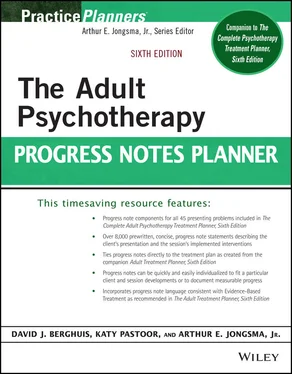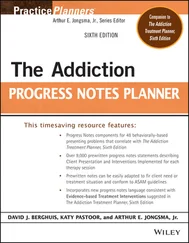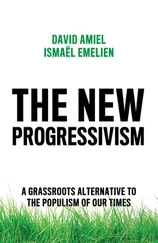8 Refer for Medication Evaluation (8)The client was referred to a prescribing clinician to evaluate him/her/them for psychotropic medication to reduce symptoms of ADHD.The client has completed an evaluation by the prescribing clinician and has begun taking ADHD medications.The client has resisted the referral to a prescribing clinician and does not want to take any medication to reduce ADHD levels; his/her/their concerns were processed.
9 Monitor Medication Adherence (9)The client has begun taking medications for ADHD symptoms and the side effects and effectiveness were processed.The client has struggled to adhere to regularly taking medication for ADHD symptoms and his/her/their concerns were processed.The client has not begun taking medications for ADHD symptoms and was redirected to do so.
10 Arrange Substance Abuse Evaluation (10)The client's use of alcohol and other mood-altering substances was assessed.The client was assessed to have a pattern of mild substance use.The client was assessed to have a pattern of moderate substance use.The client was assessed to have a pattern of severe substance use.The client was referred for a substance use treatment.The client was found to not have any substance use concerns.
11 Assess Level of Insight (11)The client's level of insight toward the presenting problems was assessed.The client was assessed in regard to the syntonic versus dystonic nature of his/her/their insight about the presenting problems.The client was noted to demonstrate good insight into the problematic nature of the behavior and symptoms.The client was noted to be in agreement with others' concerns and is motivated to work on change.The client was noted to be ambivalent regarding the problems described and is reluctant to address the issues as a concern.The client was noted to be resistant regarding acknowledgment of the problem areas, is not concerned about them, and has no motivation to make changes.
12 Assess for Correlated Disorders (12)The client was assessed for evidence of research-based correlated disorders.The client was assessed in regard to his/her/their level of vulnerability to suicide.The client was identified as having a comorbid disorder, and treatment was adjusted to account for these concerns.The client has been assessed for any correlated disorders, but none were found.
13 Assess for Culturally Based Confounding Issues (13)The client was assessed for age-related issues that could help to better understand his/her/their clinical presentation.The client was assessed for gender-related issues that could help to better understand his/her/their clinical presentation.The client was assessed for cultural syndromes, cultural idioms of distress, or culturally based perceived causes that could help to better understand his/her/their clinical presentation.Alternative factors have been identified as contributing to the client's currently defined “problem behavior,” and these were taken into account in regard to his/her/their treatment.Culturally based factors that could help to account for the client's currently defined “problem behavior” were investigated, but no significant factors were identified.
14 Assess Severity of Impairment (14)The severity of the client's impairment was assessed to determine the appropriate level of care.The client was assessed in regard to his/her/their impairment in social, relational, vocational, and occupational endeavors.It was reflected to the client that his/her/their impairment appears to create mild to moderate effects on the client's functioning.It was reflected to the client that his/her/their impairment appears to create severe to very severe effects on the client's functioning.The client was continuously assessed for the severity of impairment, as well as the efficacy and appropriateness of treatment.
15 Identify Difficult ADHD Behaviors (15)The client was assisted in identifying the specific ADHD behaviors that have caused him/her/them the most difficulty.The client was supported as he/she/they listed such things as distractibility, lack of concentration, impulsivity, restlessness, and disorganization as the most difficult for him/her/them.The client was assisted in identifying specific behaviors that will be treatment targets.The client was resistive to becoming specific about identifying ADHD behaviors that cause him/her/them the most difficulty; he/she/they were encouraged to do this as he/she/they feel capable.
16 Review Evaluation Results (16)The results of the psychological testing and physician's evaluation were reviewed again with the client in order to assist him/her/them in the choice of his/her/their most difficult, problematic behaviors to address in counseling.The client was assisted in selecting those behaviors that are most difficult as focal points for treatment.The client was supported as he/she/they agreed to concentrate his/her/their efforts to change on these most difficult behavior areas.
17 Direct Family to Rank Client's Behaviors (17)The client was asked to request family members to complete a ranking of the three behaviors that they perceive as those that interfere the most with the client's daily functioning.Family members have ranked the client's behavior and have identified those three behaviors that they perceive to be the most problematic for the client; these were processed with the client.It was noted that the client's family has refused to cooperate with ranking his/her/their behaviors and would not provide such a list for him/her/them.The client has failed to ask for the family's participation in his/her/their treatment and has not asked them to rank his/her/their problematic behaviors; he/she/they were asked to get this feedback.
18 List Negative ADHD Consequences (18)The client was asked to make a list of the negative consequences that result from his/her/their problematic ADHD behaviors.The client was assigned “Impulsive Behavior Journal” in the Adult Psychotherapy Homework Planner (Jongsma).The list of the negative consequences that result from ADHD behaviors was processed to increase the client's awareness of the impact of his/her/their behavior on self and others.Coping strategies were reviewed that could be implemented as alternatives to the problematic ADHD behaviors that produce negative consequences.The client was guarded about making a list of the negative consequences that result from his/her/their problematic ADHD behaviors and was gently offered examples in this area.
19 Engage Significant Other (19)The client was directed to invite a significant other to participate in the therapy.The significant other was trained to help support the change and reduce friction in the relationship introduced by the ADHD.It was reflected that the significant other has been helpful in supporting the client's changes and reducing friction in the relationship.The significant other has struggled to be helpful to the client's change process and was provided with remedial feedback in this area.
20 Train the Coach in HOPE Technique (20)The person selected by the client to act as his/her/their coach was trained in the Help, Obligations, Plans, and Encouragement (HOPE) technique as described in the book Driven to Distraction (Hallowell and Ratey).The coach was trained in how to assist the client with Help, Obligations, Plans, and Encouragement as part of the HOPE procedure.The coach technique has been implemented and the client reported that it has been helpful in increasing his/her/their organization and task focus.The client and the coach have failed to implement the HOPE technique, and the client was encouraged to initiate this procedure.
21 Educate About Symptoms of ADHD (21)The client was taught about the signs and symptoms of ADHD.Emphasis was placed on how symptoms of ADHD disrupt functioning through the influence of distractibility, poor planning and organization, maladaptive thinking, frustration, impulsivity, and procrastination.The client was reinforced for his/her/their clear understanding of the signs and symptoms of ADHD.The client has struggled with understanding the signs and symptoms of his/her/their ADHD and was provided with remedial feedback in this area.
Читать дальше












